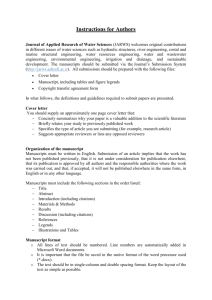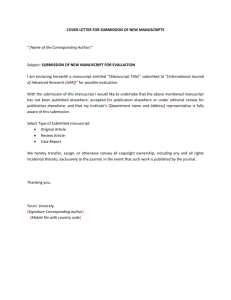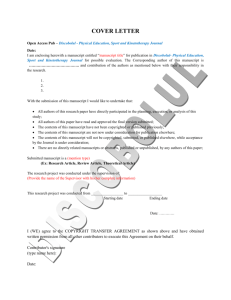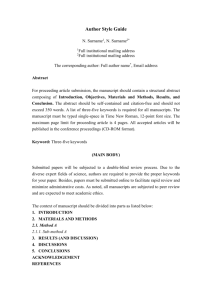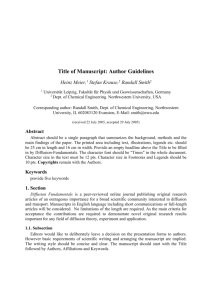Author guidelines JSLCH - Official Website of the Sri Lanka
advertisement
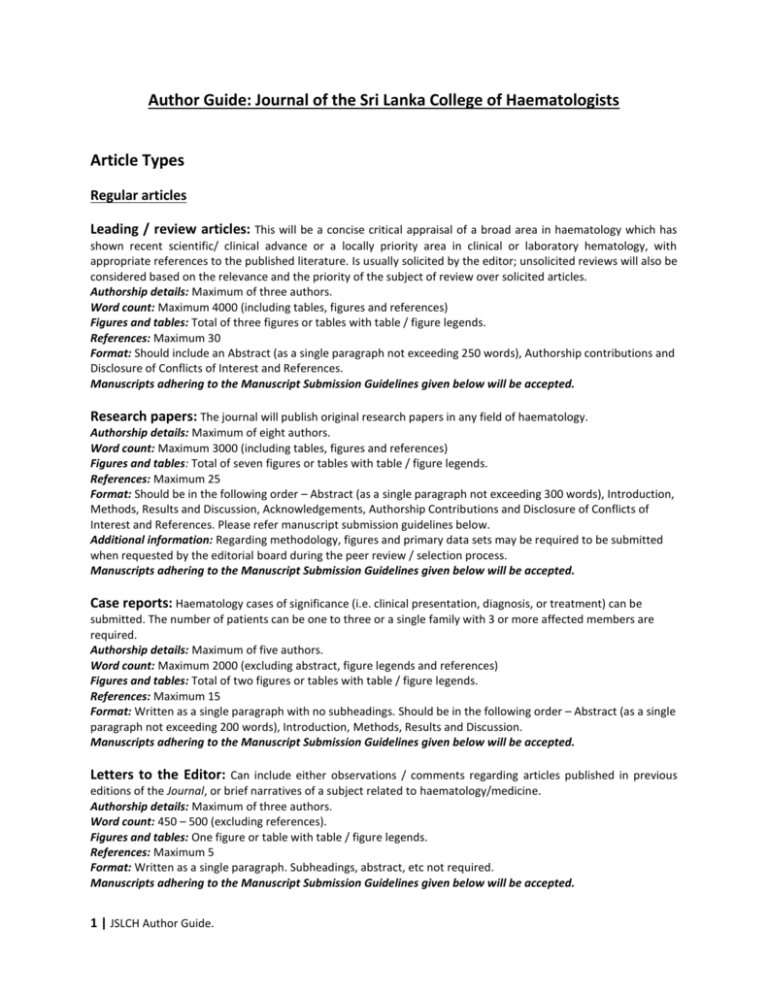
Author Guide: Journal of the Sri Lanka College of Haematologists Article Types Regular articles Leading / review articles: This will be a concise critical appraisal of a broad area in haematology which has shown recent scientific/ clinical advance or a locally priority area in clinical or laboratory hematology, with appropriate references to the published literature. Is usually solicited by the editor; unsolicited reviews will also be considered based on the relevance and the priority of the subject of review over solicited articles. Authorship details: Maximum of three authors. Word count: Maximum 4000 (including tables, figures and references) Figures and tables: Total of three figures or tables with table / figure legends. References: Maximum 30 Format: Should include an Abstract (as a single paragraph not exceeding 250 words), Authorship contributions and Disclosure of Conflicts of Interest and References. Manuscripts adhering to the Manuscript Submission Guidelines given below will be accepted. Research papers: The journal will publish original research papers in any field of haematology. Authorship details: Maximum of eight authors. Word count: Maximum 3000 (including tables, figures and references) Figures and tables: Total of seven figures or tables with table / figure legends. References: Maximum 25 Format: Should be in the following order – Abstract (as a single paragraph not exceeding 300 words), Introduction, Methods, Results and Discussion, Acknowledgements, Authorship Contributions and Disclosure of Conflicts of Interest and References. Please refer manuscript submission guidelines below. Additional information: Regarding methodology, figures and primary data sets may be required to be submitted when requested by the editorial board during the peer review / selection process. Manuscripts adhering to the Manuscript Submission Guidelines given below will be accepted. Case reports: Haematology cases of significance (i.e. clinical presentation, diagnosis, or treatment) can be submitted. The number of patients can be one to three or a single family with 3 or more affected members are required. Authorship details: Maximum of five authors. Word count: Maximum 2000 (excluding abstract, figure legends and references) Figures and tables: Total of two figures or tables with table / figure legends. References: Maximum 15 Format: Written as a single paragraph with no subheadings. Should be in the following order – Abstract (as a single paragraph not exceeding 200 words), Introduction, Methods, Results and Discussion. Manuscripts adhering to the Manuscript Submission Guidelines given below will be accepted. Letters to the Editor: Can include either observations / comments regarding articles published in previous editions of the Journal, or brief narratives of a subject related to haematology/medicine. Authorship details: Maximum of three authors. Word count: 450 – 500 (excluding references). Figures and tables: One figure or table with table / figure legends. References: Maximum 5 Format: Written as a single paragraph. Subheadings, abstract, etc not required. Manuscripts adhering to the Manuscript Submission Guidelines given below will be accepted. 1 | JSLCH Author Guide. Images in Haematology: Images of clinical (clinical photograph, radiology image) or laboratory haematology (blood, bone marrow, tissue – cytology, histology, molecular, cytogenetic, or other laboratory test) of importance will be considered. Authorship details: Maximum of three authors. Word count: Maximum 150 words (including figure legend and references – maximum 2) which should be an explanatory text of the image with reference to the clinical case. Image: Digital images in JPEG format should be submitted. The original image should be presented and any form of manipulation of the image using soft ware is strongly discouraged, unless absolutely necessary and this should be stated in the explanatory text. Manuscripts adhering to the Manuscript Submission Guidelines given below will be accepted. Other regular features Editorial: Letters are published on matters of current interest in the field of haematology / matters presented in the current journal by the editor. CME article: This will include either a case report followed by questions or a short review of a topic of current importance to post graduate trainees. CME article is usually solicited by the editor; however authors who wish to submit CME articles may contact the editor. Word count: Maximum 1000 words. References: Maximum 15. Other article types Perspectives: Articles which discuss a current / important topic in haematology based on the experiences of a specialist in that particular filed. Is usually solicited by the editor; unsolicited articles will also be considered based on the relevance and the priority of the subject over solicited articles. Word count: Maximum 3000 (including tables, figures and references) Figures and tables: Total of two figures or tables with table / figure legends. References: Maximum 15 Format: Should be in the following order – Topic, Abstract (as a single paragraph not exceeding 300 words), background of the subject discussed, authors experiences and views and suggest further actions / recommendations. Acknowledgements, Authorship Contributions and Disclosure of Conflicts of Interest and should be included. Manuscripts adhering to the Manuscript Submission Guidelines given below will be accepted. 2 | JSLCH Author Guide. Manuscript submission 1. Covering letter: Should include the following information. 1.1 Details regarding previous publications (any format) using same data sets or patient details. Any such work should be referred to specifically and referenced in the new paper. Copies of such material should be included with the submitted paper. 1.2 A statement that the manuscript has been read and approved by all the authors as final, that the authors and contributors meet the criteria stated in the Manuscript submission guidelines given below, and that each author believes that the manuscript represents honest work carried out by them and takes full responsibility of the published material. 1.3 A statement stating that the work in the manuscript has not been previously published (except in the form of an abstract or as part of a published lecture, or thesis) or under consideration for publication in another journal and if and when the manuscript is accepted for publication, the authors agree to automatic transfer of the copyright to the publisher. 1.4 In case if the submitted manuscript has previously been submitted but not accepted by another journal, statement to that effect with accompanying details – the submitted manuscript and the previous editor’s and reviewers’ comments and the authors’ responses to those comments. (Note: This will is not prejudice the acceptance of the submitted manuscript, but in doing so may help in the review process). 2. Submission format: Electronic submission is preferred and can be submitted as an email attachment to the official email of the Sri Lanka College of Haematologists - slchaem@yahoo.com under the title “Journal Article Submission 2013” followed by a hard copy to reach via mail to the above address. (Microsoft word file - 2007 version). Hard copies to be send to the Editor, Journal of the Sri Lanka College of Haematologists, 6 Wijerama Mawatha, Colombo 7, Sri Lanka. Number of copies: Please include three hard copies of the manuscript printed single side on A4 size paper and one soft copy in a CD in Microsoft word format (version 2007). Pre-submission check list: All tick boxes should be ticked and the page attached to the covering letter. Manuscripts with incomplete checklists will be returned to the author. 3. An email to acknowledgement of receipt of the manuscript will be sent to the corresponding author within 48 hours of receipt of the manuscript and further correspondence and proofs (of accepted articles) will be sent to the corresponding author before publication. 4. Selection for publication and peer review. All articles received at the Sri Lanka College of Haematologists will be submitted anonymously to the Editorial Board. Those selected for review will be sent anonymously to reviewers who will be requested to treat the manuscripts as confidential communications and not to share their content with anyone except colleagues they have asked to assist them in reviewing, or to use content for their own purposes. They are asked to declare any conflict of interest (such as personal ties to authors), and not to copy manuscripts. Editorial board reserves the right to modify style, shorten articles, make editorial corrections where necessary, and to determine priority and time of publication. 5. Fees and charges – None. The printing and other costs of the Journal is funded fully by the Sri Lanka College of Haematologists. 3 | JSLCH Author Guide. Manuscript submission Guidelines: 1. Authorship and Contributorship Those who meet all the following criteria qualify for authorship of the submitted manuscript: 1) Substantial contributions to conception and design, acquisition of data, or analysis and interpretation of data; 2) Drafting the article or revising it critically for important intellectual content; and 3) Final approval of the version to be published. Each author should have participated sufficiently in the work to take public responsibility for appropriate portions of the content. Acquisition of funding, collection of data, or general supervision of the research group alone does not constitute authorship. Contributors: All contributors who do not meet the criteria for authorship should be listed in an acknowledgments section. E.g. those who provided purely technical help (study design, data collection, data analysis), or help in manuscript preparation or administrative support (department head). The authors should disclose the identity of the individuals who provided this assistance and the entity that supported it in the published article. Financial and material support should also be acknowledged. Clinical investigators / participating investigators: Groups of persons who have contributed materially to the paper but whose contributions do not justify authorship. Their function or contribution should be described; e.g. served as scientific advisors, critically reviewed the study proposal, collected data, or provided and cared for study patients. These persons must give written permission to be acknowledged. 2. Ethical issues Privacy and Confidentiality Identifying information, including names, initials, or hospital numbers of patients / families, should not be included in any written descriptions, photographs, or pedigrees unless the information is essential for scientific purposes and the patient (or parent or guardian) gives written informed consent for publication. (Informed consent for this purpose requires that an identifiable patient be shown the manuscript to be published.) When reporting experiments on human subjects, authors should indicate whether the procedures followed were in accordance with the ethical standards of the responsible committee on human experimentation (institutional and national) and with the Helsinki Declaration of 1975, as revised in 2008 (5). If doubt exists whether the research was conducted in accordance with the Helsinki Declaration, the authors must explain the rationale for their approach and demonstrate that the institutional review body explicitly approved the doubtful aspects of the study. When reporting experiments on animals, authors should indicate whether the institutional and national guide for the care and use of laboratory animals was followed. A written statement attesting that authors have received and archived informed written consent from patient or parent or guardian and obtained ethical clearance for the study form relevant ethics committee/s with supporting documents should be included when submitting the manuscript. When informed consent has been obtained, it should be indicated in the published article. 3. Manuscript format Text should be written in capital and lower case, Arial font, font size 12 and double line spacing of all the text; including the title page, abstract, text, acknowledgments, references, individual tables, and legends. 4 | JSLCH Author Guide. All pages should be numbered consecutively, beginning with the title page. All images / figures and tables should be included within the text at the appropriate place. All images/figures should be in JPEG format and soft copies of all images should also be sent in a separate file in the same CD where the copy of the manuscript is sent. 3.1 Title Page The title page should have the following information: 1. Article title. Need to be concise, however should include all important relevant information. 2. Authors’ names (initials followed by family name, numbered according to the order to be published) and institutional affiliations. 3. The name of the department(s) and institution(s) to which the work should be attributed. 4. Details of the author responsible for correspondence about the manuscript (corresponding author). Include all following details - name, mailing address, telephone and fax numbers, and e-mail address. 5. The name and address of the author to whom requests for reprints should be addressed or a statement that reprints are not available from the authors. 6. Source(s) of support in the form of grants, equipment, drugs, or all of these. 7. Word counts. A word count for the text only (excluding abstract, acknowledgments, figure legends, and references). 8. The total number of figures and tables in the manuscript. 3.2 Conflict-of-interest notification page This should follow the title page in all manuscripts submitted to the journal. All potential conflicts of interest related to individual Authors' commitments should be stated. This includes disclosing all financial and personal relationships that might bias their work. Authors must state explicitly whether potential conflicts do or do not exist without any ambiguity. 3.3 Manuscript subsections Abstract: Should be informative and completely self-explanatory, briefly present the topic, state the scope of the experiments, indicate significant data, and point out major findings and conclusions. Complete sentences, active verbs, and the third person should be used, and the abstract should be written in the past tense. Standard nomenclature should be used and abbreviations should be avoided. No literature should be cited. Introduction: should provide a clear statement of the problem, the relevant literature on the subject, and the proposed approach or solution. It should be understandable to colleagues from a broad range of scientific disciplines. Materials and methods: should be complete enough to allow experiments to be reproduced. However, only truly new procedures should be described in detail; previously published procedures should be cited, and important modifications of published procedures should be mentioned briefly. Capitalize trade names and include the manufacturer's name and address. Subheadings should be used. Methods in general use need not be described in detail. Results: should be presented with clarity and precision. The results should be written in the past tense when describing findings in the authors' experiments. Previously published findings should be written in the present tense. Results should be explained, but largely without referring to the literature. Discussion, speculation and detailed interpretation of data should not be included in the Results but should be put into the Discussion section. Discussion: should interpret the findings in view of the results obtained in this study and compare to past studies on this topic. The Results and Discussion sections can include subheadings, and when appropriate, both sections can be combined. 5 | JSLCH Author Guide. Conclusion: State the conclusions in a few sentences at the end of the paper. Acknowledgments: of people, grants, funds, etc should be brief. Keywords: To indicate below the abstract. Maximum 5. Should help to cross index/trace the article. References: In the text, a reference should be identified by a square bracketed numerical value e.g. [1]. When there are more one reference to be cited, it should be given as [2,3] or [3-6]. 3.4 Reference Style and Format: Articles in Journals 1. Standard journal article: List the first six authors followed by et al. and addition of a database's unique identifier for the citation should be included in all references. E.g.: Halpern SD, Ubel PA, Caplan AL. Solid-organ transplantation in HIV-infected patients. N Engl J Med. 2002 Jul 25;347(4):284-7. PubMed PMID: 12140307. Forooghian F, Yeh S, Faia LJ, Nussenblatt RB. Uveitic foveal atrophy: clinical features and associations. Arch Ophthalmol. 2009 Feb;127(2):179-86. PubMed PMID: 19204236; PubMed Central PMCID: PMC2653214. 2. Organization as author E.g.: Diabetes Prevention Program Research Group. Hypertension, insulin, and proinsulin in participants with impaired glucose tolerance. Hypertension. 2002;40(5):679-86. 3. Both personal authors and organization as author (List all as they appear in the byline.) E.g.: Vallancien G, Emberton M, Harving N, van Moorselaar RJ; Alf-One Study Group. Sexual dysfunction in 1,274 European men suffering from lower urinary tract symptoms. J Urol. 2003;169(6):2257-61. 4. No author given E.g.: 21st century heart solution may have a sting in the tail. BMJ. 2002;325(7357):184. 5. Volume with supplement E.g.:Geraud G, Spierings EL, Keywood C. Tolerability and safety of frovatriptan with short- and long-term use for treatment of migraine and in comparison with sumatriptan. Headache. 2002;42 Suppl 2:S93-9. 7. Issue with supplement E.g.: Glauser TA. Integrating clinical trial data into clinical practice. Neurology. 2002;58(12 Suppl 7):S6-12. 8. Article published electronically ahead of the print version E.g.: Yu WM, Hawley TS, Hawley RG, Qu CK. Immortalization of yolk sac-derived precursor cells. Blood. 2002 Nov 15;100(10):3828-31. Epub 2002 Jul 5. Books and Other Monographs 9. Personal author(s) E.g.: Murray PR, Rosenthal KS, Kobayashi GS, Pfaller MA. Medical microbiology. 4th ed. St. Louis: Mosby; 2002. 10. Editor(s), compiler(s) as author E.g. :Gilstrap LC 3rd, Cunningham FG, VanDorsten JP, editors. Operative obstetrics. 2nd ed. New York: McGraw-Hill; 2002. 6 | JSLCH Author Guide. 11. Author(s) and editor(s) E.g.:Breedlove GK, Schorfheide AM. Adolescent pregnancy. 2nd ed. Wieczorek RR, editor. White Plains (NY): March of Dimes Education Services; 2001. 12. Organization(s) as author E.g.:Advanced Life Support Group. Acute medical emergencies: the practical approach. London: BMJ Books; 2001. 454 p. 13. Chapter in a book E.g. Meltzer PS, Kallioniemi A, Trent JM. Chromosome alterations in human solid tumors. In: Vogelstein B, Kinzler KW, editors. The genetic basis of human cancer. New York: McGraw-Hill; 2002. p. 93-113. 14. Conference proceedings E.g.: Harnden P, Joffe JK, Jones WG, editors. Germ cell tumours V. Proceedings of the 5th Germ Cell Tumour Conference; 2001 Sep 13-15; Leeds, UK. New York: Springer; 2002. 15. Conference paper E.g. :Christensen S, Oppacher F. An analysis of Koza's computational effort statistic for genetic programming. In: Foster JA, Lutton E, Miller J, Ryan C, Tettamanzi AG, editors. Genetic programming. EuroGP 2002: Proceedings of the 5th European Conference on Genetic Programming; 2002 Apr 3-5; Kinsdale, Ireland. Berlin: Springer; 2002. p. 182-91. 16. Scientific or technical report Issued by funding/sponsoring agency: E.g.: Yen GG (Oklahoma State University, School of Electrical and Computer Engineering, Stillwater, OK). Health monitoring on vibration signatures. Final report. Arlington (VA): Air Force Office of Scientific Research (US), Air Force Research Laboratory; 2002 Feb. Report No.: AFRLSRBLTR020123. Contract No.: F496209810049. Issued by performing agency: E.g.: Russell ML, Goth-Goldstein R, Apte MG, Fisk WJ. Method for measuring the size distribution of airborne Rhinovirus. Berkeley (CA): Lawrence Berkeley National Laboratory, Environmental Energy Technologies Division; 2002 Jan. Report No.: LBNL49574. Contract No.: DEAC0376SF00098. Sponsored by the Department of Energy. Unpublished Material 17. In press or Forthcoming E.g.: Tian D, Araki H, Stahl E, Bergelson J, Kreitman M. Signature of balancing selection in Arabidopsis. Proc Natl Acad Sci U S A. Forthcoming 2002. Electronic Material 18. CD-ROM E.g.: Anderson SC, Poulsen KB. Anderson's electronic atlas of hematology [CD-ROM]. Philadelphia: Lippincott Williams & Wilkins; 2002. 19. Journal article on the Internet E.g.: Abood S. Quality improvement initiative in nursing homes: the ANA acts in an advisory role. Am J Nurs [Internet]. 2002 Jun [cited 2002 Aug 12];102(6):[about 1 p.]. Available from: http://www.nursingworld.org/AJN/2002/june/Wawatch.htmArticle 20.Article with a Digital Object Identifier (DOI): E.g.: Zhang M, Holman CD, Price SD, Sanfilippo FM, Preen DB, Bulsara MK. Comorbidity and repeat admission to hospital for adverse drug reactions in older adults: retrospective cohort study. BMJ. 2009 Jan 7;338:a2752. doi: 10.1136/bmj.a2752. PubMed PMID: 19129307; PubMed Central PMCID: PMC2615549. 21. Monograph on the Internet 7 | JSLCH Author Guide. E.g.: Foley KM, Gelband H, editors. Improving palliative care for cancer [Internet]. Washington: National Academy Press; 2001 [cited 2002 Jul 9]. Available from: http://www.nap.edu/books/0309074029/html/. For further information please visit sample References at: http://www.nlm.nih.gov/bsd/uniform_requirements.html. 3.5 Tables Each table should be cited in the text. Number tables consecutively in the order of their first citation in the text and supply a brief title for each. Type or print each table with double-spacing on a separate sheet of paper. Do not use internal horizontal or vertical lines. Give each column a short or an abbreviated heading. Place explanatory matter in footnotes. Explain all nonstandard abbreviations in footnotes, and use the following symbols, in sequence: *, †, ‡, §, , ¶, **, ††, ‡‡, §§, , ¶¶, etc. Identify statistical measures of variations, such as standard deviation and standard error of the mean. If data from another published or unpublished Source is used obtain permission and acknowledge that source fully. Additional tables containing backup data too extensive to publish should be submitted with the paper to enable access to the peer reviewers. An appropriate statement should be added to the text to inform readers that this additional information is available. 3.6 Figures Need to provide separately in electronic files of figures in a format JPEG or GIF. Should be numbered consecutively according to the order in which they have been cited in the text. Letters, numbers, and symbols on figures should be clear and large enough to remain legible when the figure is reduced for publication. Photomicrographs should have internal scale markers where necessary. Symbols, arrows, or letters used in photomicrographs should contrast with the background. Photographs of potentially identifiable people must be accompanied by written permission to use the photograph. If a figure has been published previously, acknowledge the original source and submit written permission from the copyright holder to reproduce the figure, except for documents in the public domain. 3.7 Legends for Illustrations (Figures) Figures should be made as self-explanatory as possible. Type or print out legends for illustrations using double spacing, starting on a separate page, with Arabic numerals corresponding to the illustrations (figures). When symbols, arrows, numbers, or letters are used to identify parts of the illustrations, identify and explain each one clearly in the legend. Explain the internal scale/magnification and identify the method of staining in photomicrographs. 3.8 Units of Measurement Measurements of length, height, weight, and volume should be reported in metric units (meter, kilogram, or liter) or their decimal multiples. Temperatures should be in degrees Celsius. Blood pressures should be in millimeters of mercury. Drug concentrations may be reported in either SI or mass units, but the alternative should be provided in parentheses where appropriate. 3.9 Abbreviations and Symbols Use only standard abbreviations; use of nonstandard abbreviations can be confusing to readers. Avoid abbreviations in the title of the manuscript. The spelled-out abbreviation followed by the abbreviation in parenthesis should be used on first mention unless the abbreviation is a standard unit of measurement. END -------------------------------------------------------------------------------------------------------------------------------------------------------- 8 | JSLCH Author Guide. Pre submission check list. In the submitted manuscript please ensure that all items given below are full filled and attach the checklist to the covering letter. 1. 2. 3. 4. 5. 6. 7. 8. 9. Covering letter (with statements 1.1 -1.4 covered) All required information of the authors are provided The submitted manuscript adheres to the manuscript submission guidelines The required number of copies (hard and soft copies) of the manuscript are included and they confirm to the specifications given Proof of consent documents / attesting letters referring to consent are included Proof of obtaining of ethical clearance / attesting letters referring to ethical approval is included Statement on conflict of interest (i.e. Conflict-of-interest notification page) is included Letters of permission to reproduce previously published material is/are included (if relevant only) Copies of previously published work related to the submitted manuscript is/ are included (if relevant only) 9 | JSLCH Author Guide.
